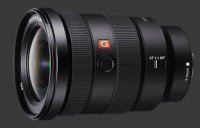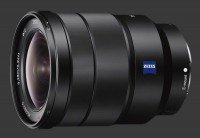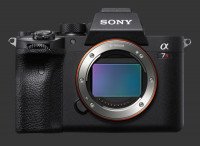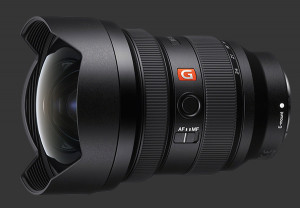Sony FE 12-24mm F/2.8GM Review
Sony FE 12-24mm F/2.8GM
After the incredible success of the Sony FE 12-24mm F/4G reviewed on the previous page of this Full-Frame Lens Roundup, the unexpected Sony FE 12-24mm F/2.8 GM faces an extremely high performance bar to justify nearly double the price at $4000 USD or $3000 CAD, compared to $1650 USD or $2200 CAD for the 12-24mm F/4G that covers exactly the same extreme-wide-angle focal-range.
Sony launched the FE 12-24mm F/2.8 GM around the middle of 2020 during the COVID-19 pandemic around the time when the cancelled Olympics were originally scheduled. This extreme-wide-angle G-Master zoom lens overtook the three year old Sony FE 16-35mm F/2.8 GM
Sony FE 16-35mm F/2.8 GM as widest lens of the premium series which itself succeeded an F/4 version co-developped with Zeiss
Sony FE Vario-Tessar T* 16-35mm F/4 ZA OSS three years earlier.

The Sony FE 12-24mm F/2.8 GM is the ultimate ultra-wide zoom lens. Its combination of extremely wide angle-of-view and bright aperture is unmatched by any Full-Frame lens on any platform. Only a single equivalent lens exists in the form of the almost equally bulky Fujifilm Fujinon XF8-16mm F/2.8R LM WR
Fujifilm Fujinon XF8-16mm F/2.8R LM WR for APS-C cameras. These lenses cover a 122 - 84° field-of-view while maintaining a constant bright F/2.8 maximum aperture.
With its huge field-of-view, the FE 12-24mm F/2.8 GM is perfect for photographing the architecture of enormous structures, buildings and monuments as well as sweeping landscapes. Its standout F/2.8 aperture takes it to the next level when such extremely wide field-of-view is needed in low-light, from poorly lit buildings and interiors of cathedrals to starlit landscapes.

Even though F/2.8 is a bright aperture surpassed only by a handful of zooms, ultra-wide lenses never produce a shallow depth-of-field. Most subjects still require stopping down to be completely in focus, unless captured on a perfectly flat plane. Note that depth-of-field is perceptual and more stopping down is required when displaying images at larger sizes. The 9-blade aperture in this lens can be stopped-down to F/22 which is beyond the diffraction limit of most digital cameras.
Exactly like the lighter Sony FE 12-24mm F/4G, the F/2.8 GM can focus down to 28cm which translates into a maximum magnification of 0.14X. Quadruple linear motors move internal lens element to adjust focus efficiently. Sony uses a similar construction between their two widest zooms. Zooming is entirely contained within the lens barrel but it is not completely internal. When zooming in, the front elements retreats deeper into the barrel which automatically improved coverage of the fixed petal-type lens hood.
The high-curvature front element prevents the use of screw-on filters on the FE 12-24mm F/2.8 GM. However, this lens supports uniquely-shaped gel filters at the rear. A plastic guide is supplied to help cut filters to the exact shape. As usual with rear-mounted filters, the lens must be unmounted when changing filters.

Construction
A broadly conical body expands from 60 to 98mm in diameter between the Sony E-mount and a built-in lens hood at the front of the lens. This fixed lens hood protects a huge bulbous element and requires a special 106mm-wide cover to encapsulate it. Five cylindrical sections are interconnected by a series of 45° angles.
The Sony FE 12-24mm F/2.8 GM is very sturdy. Its lens barrel is made of high-grade plastic which holds a large amount of glass. All together, this lens tips the scale at 847g which is exactly 50% more than the F/4G! The front is noticeably heavier than the base but more-or-less balances out with the camera body when mounted. Like all G-Master lenses, the FE 12-24mm F/2.8 GM features a fully weatherproof construction.
About one third of the way from the mount to the front, there is a large zoom ring that rotates 45° clockwise from 12mm to 24mm. Its rotation is really smooth and offers just enough resistance to prevent accidental movements. Immediately after, there is a broad fly-by-wire focus-ring which turns smoothly and indefinitely without stops. A switch near the base of the lens barrel selects between AF and MF mode. Sony cameras currently allow manual-focus when the switch is set to MF or right after autofocus locks with the camera set to DMF. This forces the photographer to move the switch to MF when the camera is unable to focus.
An unmarked button on the side of the lens can be used as an additional customizable function button by most Sony mirrorless digital cameras. The button is springy with a positive audible click confirming it was pressed. Its position is easy to reach without letting go of the zoom ring. There is no image-stabilization button on this lens is unnecessary on nearly all Sony mirrorless which offer superior built-in image-stabilization which is virtually impossible to match inside a lens.
Sony FE 12-24mm F/2.8 GM Sharpness
The G-Master series dotted with a G set into a red square on the side of a lens barrel indicates the highest level of optical performance by Sony. The optics in these lenses are created to render the best possible image-quality above all else which is why the FE 12-24mm F/2.8 GM is larger and significantly heavier than the FE 12-24mm F/4G that balances quality and size.
It is impossible not to be impressed by the resolution that the Sony FE 12-24mm F/2.8 GM captures. The output from this lens is completely sharp over nearly the entire image from wide-open until diffraction starts around F/13 when mounted on a 61 megapixels Sony A7R IV. This level of performance holds at any focal-length. There is a slight amount of softness at extreme corners of images when shooting at F/2.8. By F/4, corners are much sharper and they reach peak sharpness at F/5.6.from 12 to 20mm, while it takes F/6.7 for maximum sharpness at 24mm.
This level of performance is unmatched by any extreme-wide-angle lens and gives the F/2.8 GM at least a full-stop lead over the F/4G, even more around the middle of the zoom when the F/4G shows additional softness. While central sharpness can be matched between these two lenses, corners never become as sharp on the F/4G as on the F/2.8 GM.
Shown below are 5 crops taken from a photograph, repeatedly captured for each combination of focal-length and aperture. Smaller pieces are cropped from extreme corners of the images, while the middle wide crop is taken from the center of images. Select an aperture in a row for a desired focal-length to see the crops from the corresponding image. When judging image quality, understand that these are crops from a 61 MP image which is normally used to print images up to 45x30". On a computer display, these may appear much larger which magnifies image defects.
Performance
Incredibly, there is simply no visible distortion at any focal-length with this lens. Technically, a tiny amount of pincushion distortion can be measured at wide-angle by image analysis software but it is not discernible to the human eye. This is a huge achievement for such an extremely wide lens. This leaves no distortion for the camera to correct which would be detrimental to image sharpness and composition.
Vignetting is omnipresent on ultra-wide lenses and the FE 12-24mm F/2.8 GM falls in this respect but fares better than the F/4G. At wide-angle, there is a steep 3-stops of corner sharing wide open. This improves by a stop at F/4 and another half-stop at F/5.6 but it never gets better at 12mm. From the middle of the zoom range, there is around 2-stops of vignetting at F/2.8 but closing the aperture to F/4 leaves just one stop of shading. Beyond that, improvement is minimal.
Luckily, as mentioned in the Sony FE 12-24mm F/4G review, vignetting is the easiest and safest defect to correct via software. Most Sony mirrorless cameras offer an option to do this in-camera on the fly which substantially improves results. The latest firmware on the Sony Alpha A7R IV
Sony Alpha A7R IV corrects around 1½-stops of vignetting from this lens. The leaves disturbing vignetting at extremely wide focal-lengths and maximum F/2.8 aperture. Stopping down to F/4 is slightly better but vignetting is quite obvious. At F/5.6, in-camera correction finally takes it down to an acceptable level. From the middle of the zoom range though, images start looking natural since little vignetting remains. Image processing software can easily correct the rest.
The Sony FE 12-24mm F/2.8 GM shows virtually no signs of chromatic aberrations. Other than in cases of extreme edge contrast, this lens does not cause any color fringing. Contrast is very well maintained even in backlit situations. Despite having a huge front lens element, flaring is incredibly well controlled by state-of-the-art nano crystal coatings applied to high-curvature elements.

Sony created an internal focusing system to move heavy glass elements using 4 XD linear focus-motors. The result is reasonable autofocus speed. It takes a noticeable fraction of a second to focus the FE 12-24mm F/2.8 GM which is the only metric where the FE 12-24mm F/4G does better. Given that this lens is mostly intended for static subjects, this should not be an issue. After all, those heavy optics are what makes this lens so amazing!

Conclusion
There is no doubt that the Sony FE 12-24mm F/2.8 GM is one of the greatest lenses ever made. Its combination of extremely wide field-of-view and bright aperture is a momentous challenge for optical engineering and Sony clearly succeeded. This lens is incredibly sharp with 1-1½-stops needed to make extreme corners crisp. It renders images with virtually no distortion or chromatic aberrations while being highly resistant to flare. This only leaves the issue of vignetting to correct via a combination of in-camera and software processing. With its aperture closed beyond F/5.6, which is entirely common when capturing architecture or landscapes, final images look natural.
Autofocus is definitely on the slow side but not really a concern for the majority of photographers looking at this lens. The real question is whether the FE 12-24mm F/2.8 GM is worth twice the already excellent FE 12-24mm F/4G? Even when price is not a concern, the fact that the F/2.8 GM is 50% heavier than the F/4G is an issue for travel photographers in particular. On maximum print-sizes, the better sharpness of the FE 12-24mm F/2.8 GM is noticeable but not for medium-sized prints or online use.
To produce huge prints of grandiose architecture and stunning landscapes with fine textures, the amazing Sony FE 12-24mm F/2.8 GM is currently the best lens on any platform. Its excellent construction and weatherproof body make it likely to last long enough to be worthwhile for those who plan to use it extensively.

Please Support Neocamera
All information on Neocamera is provided free of charge yet running this website is a huge endeavor. Purchases made via affiliate links found throughout the site help keep it running and up-to-date. There is no additional cost to you, so please consider buying via these links to our affilates:
If you found any information on this site valuable and did not purchase via our affiliate links, please considering donating via PayPal:
Any amount will be greatly appreaciated. Thank you for your support!
Updates
2025.01.18

Fujifilm GFX 2025 Lens Roundup
Lens Review roundup of Fujifilm GFX Medium-Format lenses. Quality, performance and handling of the GF20-35mm F/4R WR, GF30mm F/3.5 Tilt-Shift and the GF55mm F/1.7.
2024.11.18

Best 2024 Photography Gifts for Every Budget
Great gifts for photographers and photo enthusiasts selected for every budget among the best products of 2024.
2024.08.07

Eye Protection Tips for Professional Photographers
The four main considerations for professional photographers regarding eyewear.
2024.07.14

Fujifilm X100VI Review
Flagship fixed-lens compact digital camera with a 40 MP sensor and Image-Stabilization, a first for the series. Retro design featuring dual control-dials, plus direct ISO, Shutter-Speed and EC dials. Its hybrid viewfinder can switch between EVF and OVF mode.
2024.05.09

Fujifilm GFX100 II Review
Flagship 102 Megapixels Medium-Format Mirrorless Digital Camera with 8-Stop 5-Axis IBIS, 8 FPS Drive, 8K Video and 400 MP Super-Resolution capture in a weatherproof and freezeproof body with dual control-dials and dual memory-card slots.
2024.04.03

Fujifilm X-T5 Review
Newest Fujifilm flagship boasting a 40 MP APS-C sensor, 5-axis IBIS with 7-stop efficiency, 15 FPS continuous drive, 6.2K Video capture, dual control-dials and dual SDXC UHS-II slots in a sturdy weatherproof and freezeproof body.
2023.11.20

Best Digital Cameras of 2023
Find out which are the Best Digital Cameras of 2023. All the new Mirrorless Digital Cameras from entry-level to high-end professional.
2023.07.10

Fujifilm X-H2 Review
40 Megapixels APS-C Hybrid Mirrorless Digital Camera with 7-stop IBIS. Fastest shutter ever and 8K video capture. Large builtin EVF with 0.8X magnification and 5.8 MP, plus an Eye-Start Sensor. Packed with features and large number of controls in a weatherproof and freezeproof body.
2023.05.07

Sony FE 20-70mm F/4G Review
Review of the unique Sony FE 20-70mm F/4G lens. The optical zoom of this lens spans ultra-wide-angle and medium focal-length coverage, making it one of the most versatile Full-Frame lenses on the market.
2023.01.15

Huion Inspiroy Dial 2 Review
Review of the Huion Inspiroy Dial 2 tablet, a medium sized drawing surface with dual dials and customizable buttons. Connects via USB-C or Bluetooth 5.0 with Windows, Linux and Android support.
2022.12.08

How to Pack for a Photo Trip
Find out how to pack for a travel photography trip, carry your gear safely while meeting airline regulations.
2022.11.13

Best Digital Cameras of 2022
The best digital cameras of 2022. A short list of the most outstanding models in their respective categories. Choose one for yourself or as a gift.
2025.01.18
2024.11.18
2024.08.07
2024.07.14
2024.05.09
2024.04.03
2023.11.20
2023.07.10
2023.05.07
2023.01.15
2022.12.08
2022.11.13
NEWS
2025.03.26

Canon Launches Pair of Cameras and Lenses
Digital Camera ○ Lens
2025.03.25

Venus Optics Launches Vista Vision Cine Lenses
Lens
2025.03.24

Think Tank Photo Walker Pro
Bag
2025.03.20

Fujifilm First Fixed Lens Medium-Format Camera
Digital Camera
2025.02.26

Sony Launches Two New Lenses at CP+2025
Lens
2025.02.25

CP+2025 Showcases Numerous Launches
Digital Camera ○ Lens
2025.02.13

Nikon Launches 5X Full-Frame Power-Zoom Lens
Lens
2025.02.05

Nikon Refreshes Flagship Ultra-Zoom
Digital Camera
2025.02.05

Nikon Launches Ultra-Bright 35mm F/1.2 Prime Lens
Lens
2025.01.21

Fujifilm Evolves INSTAX Wide
Digital Camera
2025.01.16

Leica Launches SL3-S
Digital Camera
2025.01.14

Think Tank Photo Launches Dark Light Tactical Backpacks
Bag



















